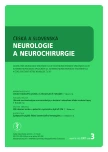Hydrocephalus after Subarachnoidal Hemorrhage – The Effects of Therapeutical Modalities for Aneurysm
Authors:
M. Mohapl; F. Kramář; V. Beneš
Authors‘ workplace:
Neurochirurgická klinika 1 LF UK a IPVZ, ÚVN, Praha
Published in:
Cesk Slov Neurol N 2007; 70/103(3): 284-289
Category:
Short Communication
Podpořeno grantem IGA MZ ČR NR/9436-3.
Overview
Hydrocephalus as a consequence of subarachnoidal hemorrhage has been a well-known and studied complication for a long period. The authors have observed the hydrocephalus incidence in a set of patients and compared the occurrence in dependence on the applied method of withdrawing the bleeding aneurysm – surgical and endovascular treatments. Within 2001–2002, 103 patients (43 males and 60 females, aged 9–85 years, mean 49.5 years) were treated immediately after subarachnoidal hemorrhage. After establishing the diagnosis, 45 patients underwent surgery, aneurysms of 58 patients were withdrawn by an endovascular method. In the further course of therapy and follow-up, 20 patients (19.4%) died. In the whole set of 103 patients the hydrocephalus incidence reached 14.6%, 11.1% in surgical subjects and 13.8% in those after coiling.
Key words:
hydrocephalus – subarachnoidal hemorrhage – surgery – endovascular treatment – coiling
Sources
1. Bagley C Jr. Blood in the cerebrospinal fluid. Resultant functional and organic alterations in the central nervous system. AO experimental data. Arch Surg 1928; 17 : 18-38.
2. Mohapl M, Kramář F, Beneš V. Hydrocefalus jako následek subarachnoidálního krvácení – review. Cesk Slov Neurol N 2004; 67 : 309-19.
3. Foltz EL, Ward AA Jr. Communicating hydrocephalus from subarachnoidbleeding. J Neurosurg 1956; 13 : 546-66.
4. Gruber A, Reinprecht A, Bavinzski G, Czech T, Richling B. Chronic shunt-dependent hydrocephalus after early surgical and early endovascular treatment of ruptured intracranial aneurysms. Neurosurgery 1999; 44 : 503-12.
5. Pietila TA, Heimberger KC, Palleske H, Brock M. Influence of aneurysm location on the development of chronic hydrocephalus following SAH. Acta Neurochir 1995; 137 : 70-3.
6. Milhorat TH. Acute hydrocephalus after aneurysmal subarachnoid hemorrhage. Neurosurgery 1987; 20 : 15-20.
7. Saveland H, Hillman J, Brandt L, Edner G, Jakobsson KE, Algers G. Overall outcome in aneurysmal subarachnoid hemorrhage. A prospective study from neurosurgical units in Sweden during a 1-year period. J Neurosurg 1992; 76 : 729-34.
8. Dorai Z, Hynan LS, Kopitnik TA, Samson D. Factors related to hydrocephalus after aneurysmal subarachnoid hemorrhage. Neurosurgery 2003; 52 : 763-71.
9. Vale FL, Bradley EL, Fisher WS. The relationship of subarachnoid hemorrhage and the need for postoperative shunting. J Neurosurg 1997; 86 : 462-6.
10. Tapaninaho A, Hernesniemi J, Vapalahti M, Niskanen M, Kari A, Luukkonen M et al. Shunt-dependent hydrocephalus after subarachnoid haemorrhage and aneurysm surgery: timing of surgery is not a risk factor. Acta Neurochir 1993; 123 : 118-24.
11. Graff-Radford NR, Torner J, Adams HP Jr, Kassell NF. Factors associated with hydrocephalus after subarachnoid hemorrhage. A report of the Cooperative Aneurysm Study. Arch Neurol 1989; 46 : 744-52.
12. Vaverka M, Charamza J, Kikalová K, Krahulík D. Morfologická studie lamina terminalis a její klinický význam. Cesk Slov Neurol N 2006; 69 : 217–21.
13. Pang D, Sclabassi RJ, Horton JA. Lysis of intraventricular blood clot with urokinase in a canine model: Part 3. Effects of intraventricular urokinase on clot lysis and posthemorrhagic hydrocephalus. Neurosurgery 1986; 19 : 553-72.
14. Vale FL, Bradley EL, Fisher WS. The relationship of subarachnoid hemorrhage and the need for postoperative shunting. J Neurosurg 1997; 86 : 462-6.
15. Sethi H, Moore A, Dervin J, Clifton A, MacSweeney JE. Hydrocephalus: comparison of clipping and embolization in aneurysm treatment. J Neurosurg 2000; 92 : 991-4.
16. Vermeij FH, Hasan D, Vermeulen M, Tanghe HL, Gijn van J. Predictive factors for deterioration from hydrocephalus after subarachnoid hemorrhage. Neurology 1994; 44 : 1851-5.
17. Yoshioka H, Inagawa T, Tokuda Y, Inokuchi F. Chronic hydrocephalus in elderly patients following subarachnoid hemorrhage. Surg Neurol 2000; 53 : 119-25.
18. Lanzino G, Kassell NF, Germanson TP, Kongable GL, Truskowski LL, Torner JC et al. Age and outcome after aneurysmal subarachnoid hemorrhage: why do older patients fare worse? J Neurosurg 1996; 85 : 410-8.
19. Sheehan JP, Polin RS, Sheehan JM, Baskaya MK, Kassell NF. Factors associated with hydrocephalus after aneurysmal subarachnoid hemorrhage. Neurosurgery 1999; 45 : 1120-8.
Labels
Paediatric neurology Neurosurgery NeurologyArticle was published in
Czech and Slovak Neurology and Neurosurgery

2007 Issue 3
Most read in this issue
- Chiari Malformation: Own Experience
- Osmotic Demyelination Syndrome – MRI Diagnosis: a Case Report
- The Brain MR Imaging in Patients with Myotonic Dystrophy DM 1
- Osteoplastic Decompressive Craniotomy
